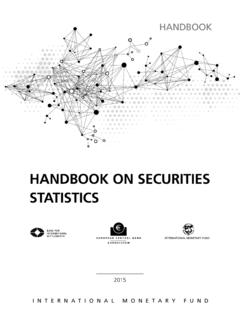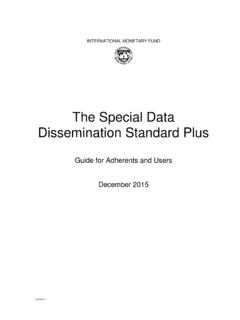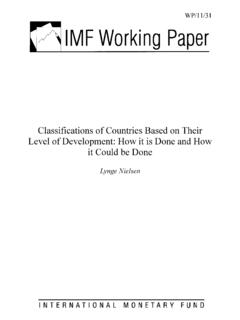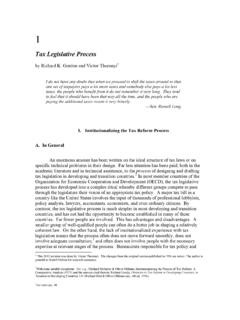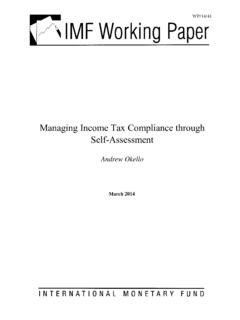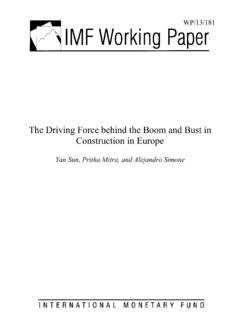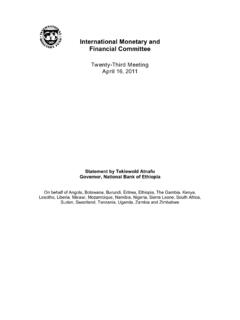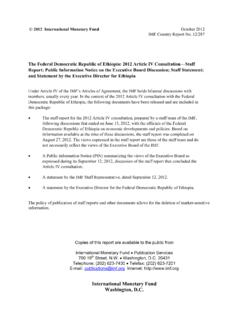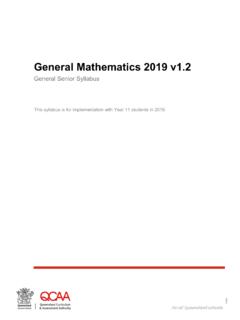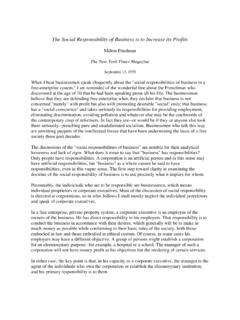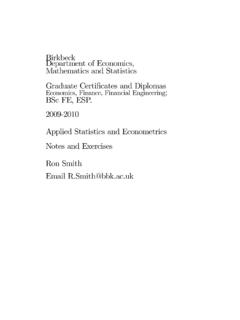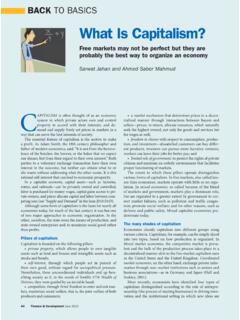Transcription of The Case for Monetary Finance – An Essentially Political Issue
1 The Case for Monetary Finance An Essentially Political Issue Adair Turner Institute for New Economic Thinking Paper presented at the 16th Jacques Polak Annual Research Conference Hosted by the International Monetary Fund Washington, DC November 5 6, 2015 The views expressed in this paper are those of the author(s) only, and the presence of them, or of links to them, on the IMF website does not imply that the IMF, its Executive Board, or its management endorses or shares the views expressed in the paper. 1166 TTHH JJAACCQQUUEESS PPOOLLAAKK AANNNNUUAALL RREESSEEAARRCCHH CCOONNFFEERREENNCCEE NNOOVVEEMMBBEERR 55 66,, 22001155 1 THE CASE FOR Monetary Finance AN Essentially Political Issue Adair Turner IMF Jacques Polak Research Conference 5th November, 2015 Consider for example a tax cut for households and businesses that is explicitly coupled with incremental Bank of Japan purchases of government debt so that the tax cut is in effect financed by money creation , Ben Bernanke, Some Thoughts on Monetary Policy in Japan, 2003 My aim in this paper to assess the possible and appropriate role for Monetary Finance of fiscal deficits.
2 And I will argue that all the really important issues are Political , since the technical issues surrounding Monetary Finance are already well understood (or should be) and that the technical feasibility and desirability in some circumstances of Monetary Finance is not in doubt. Monetary Finance of increased fiscal deficit will always stimulate aggregate nominal demand: in some circumstances it will be a more certain and/or less risky way to achieve that stimulation than any alternative policy lever: and the scale of stimulus can be appropriately calibrated and controlled there is no knife edge nonlinearity which makes dangerously high inflation inevitable. But it is also clear that great Political risks are created if we accept that Monetary Finance is a feasible policy option: since once we recognise that it is feasible, and remove any legal or conventional impediments to its use, Political dynamics may lead to its excessive use. The most important question relating to Monetary Finance is therefore whether it is possible to construct a set of rules and responsibilities which will guard against its dangerous misuse, while still enabling its use in appropriate quantities and in appropriate circumstances.
3 But the majority of this paper is still devoted to making the technical case, since the fact of technical feasibility and desirability is still not universally accepted within the economics profession, and needs to be if we are to move on to the crucial issues of Political economy. The paper is structured in four sections: 1. Defining terms. What do we mean by Monetary Finance and how is it distinguished from other policy options which might be used to stimulate nominal demand 2. The undoubted technical case for Monetary Finance . In this section I argue that the technical case for Monetary Finance is clear and undeniable. I begin by defining what I mean by technical 3. The Political risks of Monetary Finance : a manageable challenge? I argue that in principle these risks can be managed 2 4. Monetary Finance in today s economic circumstances. I argue that Monetary Finance should be an available policy tool, and that in at least one country Japan - it not only should be but inevitably will be used within the next five years.
4 I also consider whether money Finance should be used only as an emergency measure in the face of a post-crisis debt overhang, or whether, faced with possible secular stagnation, we will have to use it on a continuous basis. 1. DEFINING TERMS: DISTINGUISHING Monetary Finance FROM OTHER POLICIES Monetary Finance is defined as running a fiscal deficit (or a higher deficit than would otherwise be the case) which is not financed by the Issue of interest-bearing debt, but by an increase in the Monetary base of the irredeemable fiat non-interest-bearing Monetary liabilities of the government/central bank. The easiest way to think about this is in terms of Friedman s helicopter money , [Friedman, M. 1960] with the government printing dollar bills and then using them to make a lump-sum payment to citizens. But in modern reality It could involve either a tax cut or a public expenditure increase which would not otherwise occur. It can be one-off or repeated over time. And it would typically involve the creation of additional deposit rather than paper money.
5 This would be initially in the form of deposit money in the government s own current accounts which would then be transferred into private deposit accounts either as a tax cut or through additional public expenditure. There are a number of ways in which the money could be created with different precise implications for the central bank balance sheet. They include: The central bank directly credits the government current account (held either at the central bank itself or at a commercial bank) and records as an asset a non-interest-bearing non-redeemable due from government receivable The government issues interest-bearing debt which the central bank purchases and which is then converted to a non-interest-bearing non-redeemable due from government asset The government issues interest-bearing debt, which the central bank purchases , holds and perpetually rolls over (buying new government debt whenever the government repays old debt), returning to the government as profit the interest income it receives from the government.
6 In this case the central bank must also credibly commit in advance to this perpetual rollover. But the choice between these different precise mechanisms has no substantive economic consequences, since in all cases: (Exhibit 1a and b) 3 The consolidated balance sheet of the government and central bank together is the same. The Monetary base of irredeemable non-interest-bearing money is increased And the government is thus able to cut taxes or increase expenditure without incurring any future liability to pay more interest, or to redeem the capital value of the money created. Section 2 (i) explores how Monetary Finance , defined in these terms, is bound to stimulate aggregate nominal demand. Section 2 (ii) will then explore how such Monetary Finance differs from three possible alternative policy options: (i) Debt financed fiscal deficits (or more specifically, debt financed increases in fiscal deficit above what would otherwise be the case.) These involve tax cuts or public expenditure increases financed via the Issue of interest-bearing debt.
7 Unlike money financed deficits they do create an increased future debt servicing burden. Such operations increase the fiscal deficit and the stock of public debt but do not involve an increase in the Monetary base. (ii) Pure Monetary policy stimulus working via changes in the policy interest rate, or, if interest rates are at the zero lower bound via either (i) forward guidance on the path of future interest rates (ii) quantitative easing operations in which the central bank purchases government interest-bearing debt, but without any concurrent increase in the fiscal deficit, and with the stated intention that the debt will at some time be sold back to the private sector. QE operations involve a temporary increase in the Monetary base but no increase in the fiscal deficit or the public debt stock. (iii) Increased fiscal deficits accompanied by QE operations. Here there is both a debt financed increase in the fiscal deficit, and a temporary increase in the Monetary base. But this combination is still different from Monetary Finance because the stated intention that the QE operation will eventually be reversed means that the government still faces an increase in its long-term debt servicing burden, both in respect to interest payments and capital redemptions.
8 Such operations involve both an increase in the fiscal deficit and the public debt stock, and a temporary increase in the Monetary base. Exhibit 2 summarises the difference between the alternative options in terms of the implications for fiscal deficit, public debt stock and thus future debt servicing requirements, and the Monetary base. 2. THE UNDOUBTED TECHNICAL CASE FOR Monetary Finance I argue in this section that the technical case for treating Monetary Finance as an available policy option is undoubted, and that there are no valid technical reasons for excluding it. 4 By technical considerations I mean those which would be relevant if we could assume that the policy authorities (government and central bank) could together make and stick to credible commitments which define the circumstances in which they will deploy Monetary Finance and the quantities of Monetary Finance which they will deploy. The Political question of whether such commitments can be credible is considered in Section 3.
9 The technical case for Monetary Finance follows from 4 propositions: 1. That there exist some circumstances in which it is desirable by some policy or other to deliver a faster growth of aggregate nominal demand. 2. That Monetary Finance of increased fiscal deficits will always stimulate the growth of aggregate nominal demand. 3. That there are circumstances in which Monetary Finance will do so more certainly and with less risk of adverse side-effects than either a purely fiscal policy approach (debt financed fiscal deficits) or a purely Monetary approach (working via interest rates, forward guidance, or QE) 4. That the scale of the impact of Monetary Finance on nominal demand can be appropriately controlled. I argue that each of these propositions applies, and that in particular Propositions 2, 3, and 4 can be demonstrated with certainty on the basis of simple first principles, without the use of complex modelling. This conclusion is however supported by the formal modelling analysis which Jordi Gal presented in a recent paper, the key findings of which I therefore discuss.
10 (i) Proposition 1: there exist some circumstances in which it is desirable to stimulate faster nominal demand growth. Sections 2(ii) and (iii) will prove that Monetary Finance will always stimulate aggregate nominal demand, and that there exist circumstances in which it is a better and less risky way to do so than the alternative policy options. But that would only make Monetary Finance desirable in circumstances where aggregate nominal demand is deficient and where therefore it is desirable to stimulate nominal demand by some means or other. We must therefore agree whether Proposition 1 holds. It could be challenged on both theoretical and empirical grounds. Indeed of my four propositions this is the one which raises the most complex issues of economic theory and empirical evidence and which cannot be proved with simple and undeniable logic. Whether it applies depends Essentially on whether the real economy works in line with Classical or New Keynesian assumptions; If Classical assumptions hold, and wages and prices are sufficiently flexible, then maximum possible divergences from full employment equilibrium are always very small: there is limited if any capacity to improve economic performance by any category of demand management stimulus: and modern economies could operate efficiently even if they faced continuous mild deflation.
